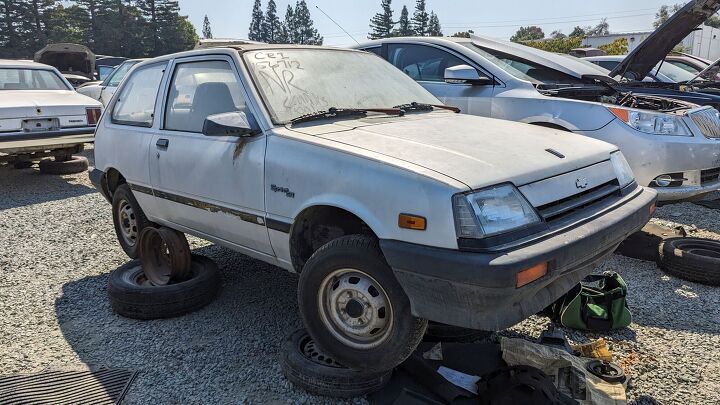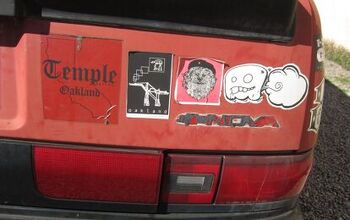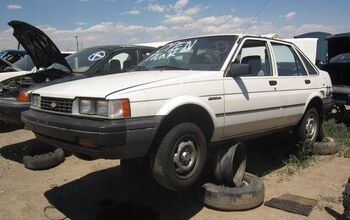Junkyard Find: 1987 Chevrolet Sprint ER

What was the most fuel-efficient (mass-produced, internal combustion-powered, highway-legal, non-gray-market, four-wheeled, et freakin' cetera) new car available in the United States during the 1980s? No, not the Toyota Starlet or Corolla Tercel, not the Honda CRX HF, not the Subaru Justy. It was the Chevrolet Sprint ER, and I've found a nicely intact example in a car graveyard just east of Sacramento.
If you want to be picky, the 1986 Sprint ER was the gas-mileage king of 1980s America, rated at 44 city and 53 highway miles per gallon. The 1987 Sprint ER came in second place, due to its insatiable thirst for go-go juice on the highway (51 miles per gallon).
In order to win the United States MPG crown for the 1985 through 1987 model years (for 1988, the Sprint Metro replaced the Sprint ER), the Sprint ER had a taller final drive gear ratio and a stingier camshaft than the regular Sprint.
It also had an upshift light (located in the lower right corner of the cluster) to remind drivers that fuel economy was more important than brisk acceleration.
Even though memories of the gas lines and fuel rationing of 1979 were still vivid by 1987, oil prices crashed hard during the middle 1980s, hitting bottom in 1986.
The MSRP for the regular '87 Sprint 3-door was $5,995, while the fuel-sipping Sprint ER 3-door listed at $6,110 (that's $16,593 and $16,912 in 2023 dollars). Not many Sprint shoppers were willing to pay the extra 115 smackers to get the ER's 47 combined miles per gallon instead of the base Sprint's 39 combined miles per gallon.
As I was contemplating the first Sprint ER I've seen in at least a couple of decades, the Air Force Thunderbirds screamed overhead as they practiced for the California Capital Airshow.
Less flashy Air Force hardware also roared by, since the junkyards of Rancho Cordova are beneath the flight path to Travis Air Force Base (which was named Fairfield-Suisun Air Force base until a B-29 carrying a "Fat Man" atomic bomb crashed and burned there, killing Brigadier General Robert F. Travis).
The heart of the Sprint was a carbureted 1.0-liter Suzuki three-cylinder engine, rated at 49 horsepower. The next-generation version of this car, the Geo Metro XFi, was the final new production car available in the United States with under 50 horses, using a fuel-injected version of the same Suzuki three-banger.
It appears that this engine was not legal for sale in high-altitude areas.
A five-speed manual was mandatory equipment on the 1987 Sprint ER. Other Sprint models could be purchased with optional automatics that year.
Back in its Japanese homeland, this car was known as the Suzuki Cultus. The second-generation version appeared here in 1989, badged as the Geo Metro. After the Geo brand got the axe in 1997, the Metro became a Chevrolet. Note the black rectangle on the hood; that's the hood release, not a badge.
The Sprint was nowhere near the cheapest new car Americans could buy in 1987. That honor went to the $3,990 Yugo GV, followed by the tied-for-second-place $4,995 Hyundai Excel 3-door hatchback and $4,995 Chevrolet Chevette (yes, new Chevettes were available that late). The Volkswagen Fox, base Subaru 3-door and Plymouth Horizon America undercut the Sprint's price as well.
As even the most miserable econoboxes got heavier and more powerful in later years, the 1986 Sprint ER's fuel-economy numbers seemed untouchable. The original Honda Insight beat it, but it needed a gasoline-electric hybrid powertrain plus a lot of cutting-edge aerodynamic and weight-reduction tricks to pull it off.
The Sprint ER shouldn't be compared to modern hybrids or EVs, though. It achieved its efficiency on straight internal combustion and did it with a carburetor.
Driving a Sprint ER from Los Angeles to New York with three passengers sounds like a nightmare. Just $66 with gas priced at $1.16 per gallon.
Also a better deal than seven horses (the hoofed variety).
Crushes the Hyundai Excel.
It loves to run!
In Canada, this car was badged as the Pontiac Firefly.
The Cultus was available with air conditioning, which would have been nice for those humid Japanese summers.
Versions of this generation of Cultus were sold everywhere, thanks to the long reach of the GM Empire
1987 Chevrolet Sprint ER in California junkyard.
1987 Chevrolet Sprint ER in California junkyard.
1987 Chevrolet Sprint ER in California junkyard.
1987 Chevrolet Sprint ER in California junkyard.
1987 Chevrolet Sprint ER in California junkyard.
1987 Chevrolet Sprint ER in California junkyard.
1987 Chevrolet Sprint ER in California junkyard.
1987 Chevrolet Sprint ER in California junkyard.
[Images: The Author]
Become a TTAC insider. Get the latest news, features, TTAC takes, and everything else that gets to the truth about cars first by subscribing to our newsletter.

Murilee Martin is the pen name of Phil Greden, a writer who has lived in Minnesota, California, Georgia and (now) Colorado. He has toiled at copywriting, technical writing, junkmail writing, fiction writing and now automotive writing. He has owned many terrible vehicles and some good ones. He spends a great deal of time in self-service junkyards. These days, he writes for publications including Autoweek, Autoblog, Hagerty, The Truth About Cars and Capital One.
More by Murilee Martin
Latest Car Reviews
Read moreLatest Product Reviews
Read moreRecent Comments
- 2ACL I have a soft spot for high-performance, shark-nosed Lancers (I considered the less-potent Ralliart during the period in which I eventually selected my first TL SH-AWD), but it's can be challenging to find a specimen that doesn't exhibit signs of abuse, and while most of the components are sufficiently universal in their function to service without manufacturer support, the SST isn't one of them. The shops that specialize in it are familiar with the failure as described by the seller and thus might be able to fix this one at a substantial savings to replacement. There's only a handful of them in the nation, however. A salvaged unit is another option, but the usual risks are magnified by similar logistical challenges to trying to save the original.I hope this is a case of the seller overvaluing the Evo market rather than still owing or having put the mods on credit. Because the best offer won't be anywhere near the current listing.
- Peter Buying an EV from Toyota is like buying a Bible from Donald Trump. Don’t be surprised if some very important parts are left out.
- Sheila I have a 2016 Kia Sorento that just threw a rod out of the engine case. Filed a claim for new engine and was denied…..due to a loop hole that was included in the Class Action Engine Settlement so Hyundai and Kia would be able to deny a large percentage of cars with prematurely failed engines. It’s called the KSDS Improvement Campaign. Ever hear of such a thing? It’s not even a Recall, although they know these engines are very dangerous. As unknowing consumers load themselves and kids in them everyday. Are their any new Class Action Lawsuits that anyone knows of?
- Alan Well, it will take 30 years to fix Nissan up after the Renault Alliance reduced Nissan to a paltry mess.I think Nissan will eventually improve.
- Alan This will be overpriced for what it offers.I think the "Western" auto manufacturers rip off the consumer with the Thai and Chinese made vehicles.A Chinese made Model 3 in Australia is over $70k AUD(for 1995 $45k USD) which is far more expensive than a similar Chinesium EV of equal or better quality and loaded with goodies.Chinese pickups are $20k to $30k cheaper than Thai built pickups from Ford and the Japanese brands. Who's ripping who off?























































Comments
Join the conversation
When you think about it it’s amazing how efficient the ICE has become. Back in the day of this Chevy Sprint you could only get such fuel economy by reducing the horsepower, cylinders, engine capacity and stuffing that engine into something small and light.
Today? I mean on Saturday I had to drive to a photo shoot precisely 160 km (100 miles) outside of Munich. I drive a 2018 Mercedes A250 AMG Line (W177) with a turbocharged 2.0 4-cylinder, 224-horsepower, 7-DCT (Double Clutch) and FWD. My car was fully loaded with heavy photographic gear including several heavy batteries for my Elinchrom 1200W portable flashes. The entire trunk and rear seats were filled with my equipment which means WEIGHT.
And yet my average fuel economy for 100 km was 6.6 liters (a solid 35 mpg). Sure, it’s not touching the fuel economy of the Chevy Sprint, but this involved spending almost 30 minutes in Munich traffic before reaching the Autobahn and then cruising at 140 km/h (87.5 mph) with several ventures into the 160-200 km/h zones in a car overloaded with heavy photographic equipment. That’s phenomenal fuel economy. Right now I am drinking water out of a 1.5 liter bottle. They are not very big and when you think about it… my car needed 4.5 bottles (1.5 liters each) to drive 100 km. Insane. As far as I am concerned this whole “But gasoline ICE engines are only 25-35% efficient in thermodynamics!” claim is irrelevant these days. Seriously.
Pic of my ride, her name is… “Priscilla”. 😆
My dad had one of these,tiny tinny little thing that he towed behind a motorhome then drove for years afterwards, from a different era of automobiles, nobody would accept the lack of amenities today